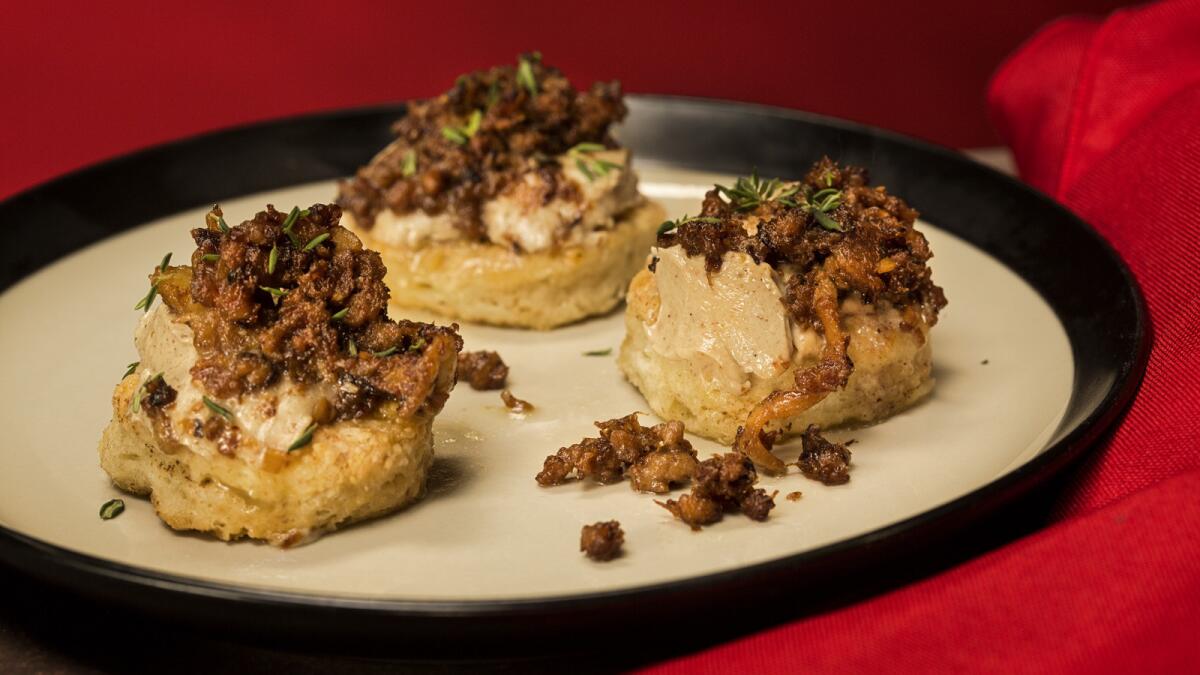Marcus Samuelsson talks about his ‘Red Rooster’ cookbook, baking biscuits and why he loves cooking to Nina Simone

Chef Marcus Samuelsson talks about the inspiration for his restaurant in the heart of Harlem, the Red Rooster. He describes the restaurant as a vibrant and rich epicenter of color, culture and flavor.
- Share via
As he throws flour across the counter in a sudden sideways dust storm, Marcus Samuelsson talks about his new cookbook, about the Harlem restaurant it chronicles and about the wider project that they both articulate. As he works the butter into the biscuit dough and stirs the contents of a sauté pan — a mash-up of chicken skin and dried shrimp, lemongrass and oyster sauce and ginger — he keeps talking.
“Food is coding. It’s class; it’s tribal,” says Samuelsson as he works the stoves of the Los Angeles Times Test Kitchen. The chef was born in Ethiopia, grew up in Sweden with his adoptive family and now lives and works in New York City. “Art, music, fashion, food: All of it is coding, and food is the least clear.” Listening to him, you feel that he’s trying to work his mission statement along with the shards of butter into the biscuits themselves, as if the conversation and the food have become parts of the same thing.
Which, in his latest cookbook, “The Red Rooster Cookbook: The Story of Food and Hustle in Harlem,” they have. What Samuelsson wants to do is more than open a restaurant, cook some food, write a cookbook: He wants to celebrate a neighborhood. And by doing so, “to hope,” as Hilton Als writes in his foreword to the book, “and to effect change.” Samuelsson wants to cook for you, but his ambitions extend considerably beyond the plate — or maybe it’s that what’s on that plate is a lot more than food.
“We have the luxury to make this with butter, it explains the journey of both luxury and poverty.”
— Marcus Samuelsson
You’ve probably heard of Samuelsson already: his rise to culinary fame at the New York restaurant Aquavit in his early 20s, his appearances on food television, his cooking for President Obama, his cookbooks and memoir, and his remarkable journey from Ethiopia to Sweden and now to Harlem, where he’s lived for almost a dozen years. Harlem is the locus for Red Rooster, the restaurant Samuelsson opened there in fall 2010, and for the book he’s written about the restaurant, its neighborhood and people. And it’s what he’s talking about now, as he’s cooking.
“I waited six years before I wrote the book for a reason,” Samuelsson says, stirring the pan in which he’s making bird funk, a hugely fragrant and deeply addictive sauce that will go onto the brown butter biscuits that are now in the oven. The restaurant had to come first, he says, then the food and the stories. These are not the sidebars and headnotes that fill most cookbooks, but pages of conversations with and often first-person accounts from the cooks and musicians, singers and shop owners who live in the neighborhood and now fill both the book’s pages and the restaurant’s chairs.

Recipe: Bird funk and chicken liver butter »
“Food is a gateway,” the chef says, now sautéing chicken livers in another pan. “We know fried chicken and gumbo and shrimp and grits, but whose food is it, who does it belong to? It’s our food. It’s American food.” Samuelsson is making something he calls chicken liver butter, an insanely rich and velvety thing — imagine foie gras buttercream.
“Think about chicken liver, about the coding between the foie gras that comes from Europe and the chicken liver that’s more rooted in Southern or poverty cooking. People love foie gras but might not like chicken liver: It’s a class thing. But it’s delicious. We can celebrate it.” Samuelsson dips a biscuit into the bowl of the Cuisinart as soon as it’s done and beckons those around him to eat. He hasn’t stopped talking.
“We have the luxury to make this with butter,” he says, scooping another biscuit. “It explains the journey of both luxury and poverty.” That journey is Samuelsson’s own, of course, from Ethiopian refugee to Swedish culinary student to one of the most lauded chefs in America. It’s also traced in his cooking: through the classical French technique, and through the flavors of Africa and of Scandinavia that are woven around recipes for shoebox ham and Obama’s short ribs and fried yardbird, the restaurant’s signature dish.
“I love high-low cooking,” says Samuelsson, the kitchen now saturated with the intense aromas of bird and butter and spice. “You need sour, you need attitude, you need something that talks back. I use a lot of Nina Simone in my cooking.”

Recipe: Brown butter biscuits »
Music plays a huge role in Samuelsson’s book: in playlists for chapters, in the stories of the Harlem community that populate the book along with the recipes, in the chef’s own narrative (it is John Legend, talking shop at the restaurant, who provides some pivotal recipe advice), and in his actual restaurant, where bands routinely come to play. The funk of the recipe is also, of course, musical.
“Music is probably the easiest way of understanding a culture; it becomes the universal language,” says Samuelsson. “Without the music, I can’t explain this neighborhood. Without the art, I can’t do it justice. Without the service and hospitality, it wouldn’t be as delicious.”
Samuelsson brushes flour from his shirt as he talks — he’s wearing a Red Rooster button-down over a T-shirt with Prince’s face and the word “vegan,” an American flag baseball cap is his contemporary toque — and wipes the last traces of brown butter from the pan with another biscuit.
“Play the music, cook the food. Bring your own funk into it. Think about who you are.”
ALSO:
This fall’s new cookbooks: 27 of our favorites
What’s up with the cookbook industry these days
New cookbooks offer recipes for Persian, Turkish and Uzbek cuisine
More to Read
Eat your way across L.A.
Get our weekly Tasting Notes newsletter for reviews, news and more.
You may occasionally receive promotional content from the Los Angeles Times.











